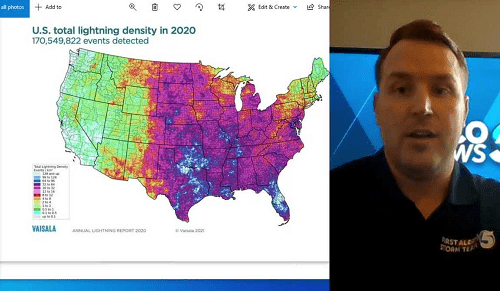
1.10.21 – KOCO – Eric Garlick
Vaisala reports that more than 17.5 million lightning events were detected in the U.S. in 2020, with Oklahoma being one of the top states for lighting strikes.
KOCO 5 Meteorologist Eric Garlick looks at those numbers and breaks down what they mean for Oklahoma. WATCH THE VIDEO
Hey, everybody. I’m first Alert meteorologist Eric Garlic, and wanted to talk to you about lightning strikes. Um, this information is put out by Visa and they use a acronym called N L D N National Lightning Detection Network. And it keeps track of all of the lightning strikes that happens. Some pretty cool stuff actually had a chance to visit, uh, their headquarters. And really, really cool, really incredible stuff.
But here’s the information that they’re they’re putting out four lightning density here in 2020 and the bright colors, the hotspots, of course. Florida, Texas and Oklahoma.
Not surprised by seeing all of those lightning strikes, and you can kind of see that front range where it is divided. And that is obviously because of the Rocky Mountains and because of the lack of moisture. Uh, the Gulf of Mexico pumps in a lot of moisture and helps fuel those thunderstorms as they move off of the front range and develop out into portions of Oklahoma in Texas. And then a lot of moisture with the Peninsula of Florida being surrounded by water and the ability to tap into that moisture. So pretty interesting data coming into us let me zoom in on here and I will show you the key first.
So events per kilometers squared. So 128 and up are the areas in white purple 32 to 64 then the lighter purple pink 12 to 16. So, as we go over into Oklahoma, you can see Ah lot of lightning across Central into eastern Oklahoma, really all across the state. But hot spots for lightning in 2020 coming in through central and eastern Oklahoma.
So some pretty cool data coming to us from again Vice Ella. And they keep track of all of those lightning strikes all across the nation. And again, it’s, um, pretty cool information from them, that is Ah, look at the data from 2020.
But how does it compare to the last couple of years? Uh, five years of data in the past will go back. Ah, little bit above average for parts of Oklahoma and a little bit below average for other parts. Michigan seeing quite a bit of lightning compared to the five year average. A little bit higher across North Dakota. Back up into Minnesota. And look at this out in California. They’ve been very dry and, ah, lot of lightning strikes there and back up into the Pacific Northwest as well. Let’s zoom in a little bit closer to Oklahoma. We’ll show you what’s going on with that, and you can see quite a bit of information coming in.
And areas in red 100% orm or above average down into Texas will focus on Oklahoma, Central and Southern Oklahoma, about anywhere up to about 25% above average for lightning strikes out across western Oklahoma and eastern Oklahoma, though we get into those cooler colors and actually about 25% below average up to 50 to 75% below average out across far southwestern Oklahoma. Information coming to us from Visa and there’s always fantastic information coming into the weather center, and we will pass it on as we get more
